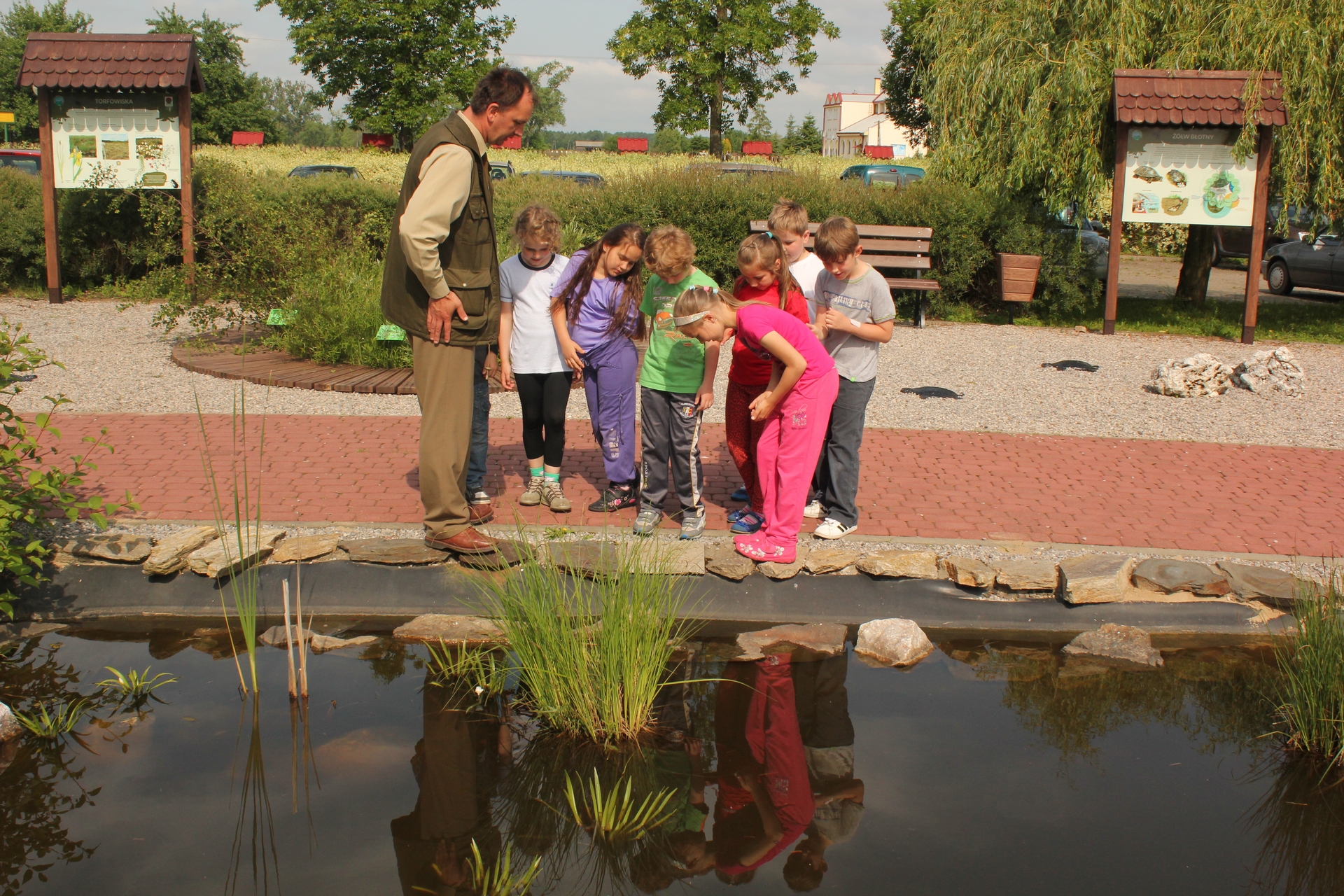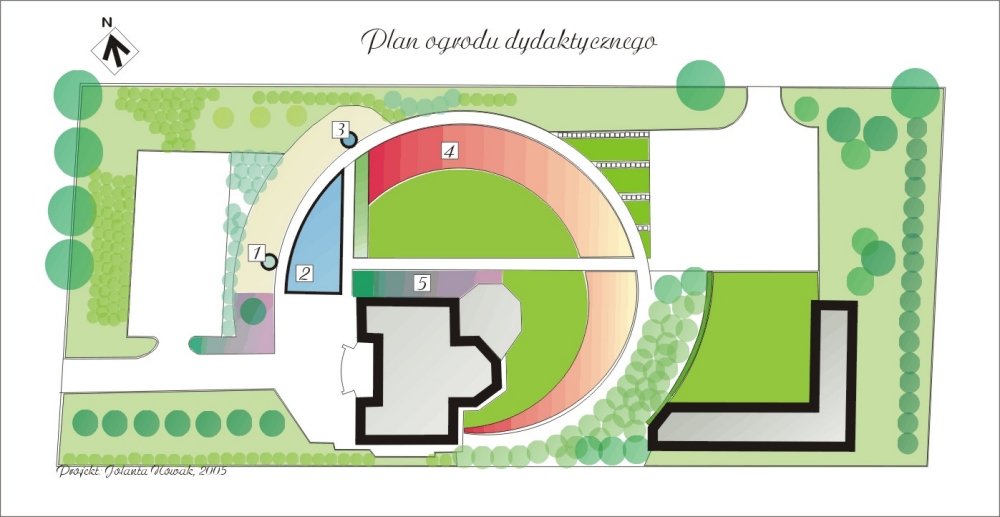The educational garden

As part of the Educational and Administrative Centre of the Poleski National Park in Urszulin, a small educational garden has been set up. Its role is to give information to the visitors on the Park’s abundance of plants. The garden is also a decoration for the management office of the Park and serves as a resting spot for its visitors. Here you can see very popular plants and the plants that are very rare. The garden is organised in a way that gives insight into selected habitats of the Park. And so we can see a piece of a transitional bog, a flower meadow and a water reservoir with an adjacent reed bed.
Special attention should be paid to the part of the garden with a small round water basin. There are plants of a transitional bog (in the garden plan marked as 1.). Here we have two very rare and protected species of shrubs: dwarf birch and downy willow. They are post-glacial relics whose most numerous populations still grow in the northern and the southern part of our country. Comparing them to popular species of birches and willows we can notice that they are characterised by dwarfism which makes their living in hard climatic conditions of tundra possible. In the water basin there is also Rosemary-leaved willow which is a similar plant. Furthermore, other species of bog plants grow here. These are shrubs derived from heathers: cranberry, bog bilberry, bog-rosemary and numerous herbaceous plants: tussock cottongrass and common cottongrass, common sedge, slender sedge and bottlesedge, jointleaf rush, purple marshlocks, garden loosestrife and tufted loosestrife, bogbean. Another plan worth seeing is calla lily, which has like-ear inflorescences with white apix pollinated by snails. Cryptogams are represented by a plant very popular in the bog: fern – marsh fern and water horsetail. The whole area is covered by many peat mosses growing in the Polesie bogs.
In the centre of the garden there is a water reservoir (the number in the plan: 2.) in which there are many nymphaea candida commonly referred to as water lilies and yellow water lilies. Both plants are protected. On the water surface you can also see leaves of the shape similar to the leaves of the aforementioned species but much smaller. These are the leaves of frogbit which together with water soldier (it is also in the water reservoir) is responsible for overgrowing of lakes. Rushes are presented on the other side of the footbridge. In the places when water is still we can see popular species: common reed, common bulrush and flowering rush spreading its pink inflorescences between them. Next to them yellow flag and single plants of purple loosestrife grow. And in the backgroud we see many plants of water-plantain.
We continue our walk along the garden and we stop by another water pool (3.) built specifically to present a very rare plant named waterwheel plant. It is one of the eight species of carnivorous plants growing in the Poleski National Park. This plant grows in only few habitats in the country and it is included in “The Polish Red Plant Book”. So, it is worth bending above water and watching a little plant grabbing zooplankton and insects’ larvae in its small traps. The mechanism of these traps is described on the nearby information board.
Next to the water pool we can find a flower meadow (4.) which can be very impressive in the early summer. Different species bloom: vetches, brown knapweed and cornflower, yellow buttercup, birdsfoot and white max chrysanthemum. Among them we can also observe yarrow. Between colorful perennials you can notice grass inflorescences: orchard grass, meadow foxtail, smooth meadow-grass. The information board describes the role of the meadows in the biodiversity and presents some birds living in this ecosystem.
In other parts of the garden we have some plant species growing in deciduous oak-hornbeam forests (5.). These include plants that are protected, e.g. white guelder rose, goat’s beard, dwarf periwinkle or European wild ginger. Protected february daphne, planted here, a small shrub with little pink flowers that unfold before leaves occur. In summer, instead of flowers, the shrub shows blood red, very poisonous fruit.
The main elements of the garden are explained on information boards and selected plant species are marked with small plates with their names. Our employees from the Park Education and Information Team will help you recognise the plants too

Na szczególną uwagę zasługuje fragment ogrodu gdzie w niewielkim zbiorniku w kształcie okręgu zaprezentowano szereg roślin związanych z torfowiskiem przejściowym (na planie ogrodu oznaczonym numerem 1.). Tutaj rosną dwa bardzo rzadkie i chronione gatunki krzewów: brzoza niska i wierzba lapońska. Są one reliktami polodowcowymi, których najliczniejsze stanowiska zachowały się jeszcze w północnej i wschodniej części naszego kraju. W porównaniu ze znanymi gatunkami brzóz i wierzb charakteryzują się one karłowatym pokrojem, co umożliwia im łatwiejsze przetrwanie w skrajnie niekorzystnych warunkach tundry. Posadzono tu również wierzbę rokitę posiadającą podobne przystosowania. Ponadto rosną tu inne gatunki związane z tego typu torfowiskami. Są to krzewinki z rodziny wrzosowatych: żurawina błotna, borówka bagienna, modrzewnica zwyczajna oraz liczne rośliny zielne: wełnianki pochwowata i wąskolistna, turzyce pospolita, nitkowata i dzióbkowata, sit członowaty, siedmiopalecznik błotny, tojeść pospolita i bukietowa, bobrek trójlistkowy. Warto przyjrzeć się również czermieni błotnej, której kolbowate kwiatostany z białymi podsadkami zapylane są przez ślimaki. Rośliny zarodnikowe reprezentują pospolite na torfowiskach: paproć - zachylnik błotny i skrzyp bagienny. Całość uzupełniają masowo porastające poleskie torfowiska mchy torfowce.
Centralne miejsce w ogrodzie zajmuje zbiornik wodny (numer na planie: 2.), w którym znajdują się grzybienie północne zwane potocznie liliami wodnymi oraz grążele żółte. Obie rośliny na stanowiskach naturalnych objęte są ochroną prawną. Na powierzchni wody zaobserwujemy również liście o kształcie podobnym do wcześniej wspomnianych gatunków, jednak dużo drobniejsze. Należą one do żabiścieku pływającego, który w naturalnych zbiornikach tworzy wraz z osoką aloesowatą (również znajduje się w oczku) zespół roślinny odpowiedzialny za szybkie lądowienie jezior. Po drugiej stronie kładki zaprezentowano roślinność szuwarową. W miejscach ze stagnującą wodą zobaczymy dobrze znane gatunki tj. trzcinę pospolitą oraz pałkę szerokolistną pomiędzy którymi rozpościera swoje różowe kwiatostany łączeń baldaszkowy. Obok nich rośnie szuwar kosaćca żółtego i pojedyncze rośliny krwawnicy pospolitej. Całości dopełniają rosnące w różnych miejscach żabieńce babki wodne.
Kontynuując naszą wędrówkę po ogrodzie należy koniecznie zatrzymać się przy kolejnym oczku wodnym (3.) utworzonym specjalnie dla wyeksponowania niezmiernie rzadkiej rośliny zwanej aldrowandą pęcherzykowatą. Jest ona jednym z ośmiu gatunków roślin mięsożernych występujących w Poleskim Parku Narodowym. Gatunek ten ma zaledwie kilka stanowisk w kraju i został wpisany do „Polskiej Czerwonej Księgi Roślin". Warto zatem pochylić się nad wodą by przyjrzeć tej niewielkiej roślince, która w pułapki zatrzaskowe chwyta zooplankton i drobne larwy owadów. Z mechanizmem działania pułapek aldrowandy zapozna nas stojąca nieopodal tablica.
Obok urządzono łąkę kwietną (4.), która na początku lata zachwyca mozaiką kolorów i różnorodnością gatunków. Kwitną wówczas różne gatunki wyk, chaber łąkowy i bławatek, żółte jaskry ostre i komonica zwyczajna, białe jastruny. Wśród nich dostrzeżemy również koszyczki krwawnika pospolitego. Spomiędzy barwnych bylin dwuliściennych wychylają się kwiatostany traw: kupkówki pospolitej, wyczyńca łąkowego, wiechliny łąkowej. Tablica edukacyjna objaśnia jak istotną rolę pełnią łąki w zachowaniu różnorodności biologicznej oraz prezentuje niektóre ptaki związane z tym ekosystemem.
W innych miejscach ogrodu rośnie kilka gatunków związanych z liściastymi lasami grądowymi (5.). Wśród nich rośliny objęte ochroną gatunkową np: biało kwitnąca kalina koralowa, parzydło leśne, barwinek pospolity czy też kopytnik pospolity. Posadzono tu również chroniony wawrzynek wilczełyko, niewielki krzew wiosną obsypany różowymi, pachnącymi kwiatkami rozwijającymi się zanim pojawią się liście. Latem w miejscach kwiatów pojawiają się krwistoczerwone, silnie trujące owoce.
Główne elementy ogrodu opisane są na tablicach edukacyjnych, a wybrane gatunki roślin oznakowane są tabliczkami z nazwami gatunkowymi. O pomoc przy rozpoznawaniu roślin znajdujących się w ogrodzie poprosić można również pracowników Zespołu ds. Edukacji i Udostępniania Parku.